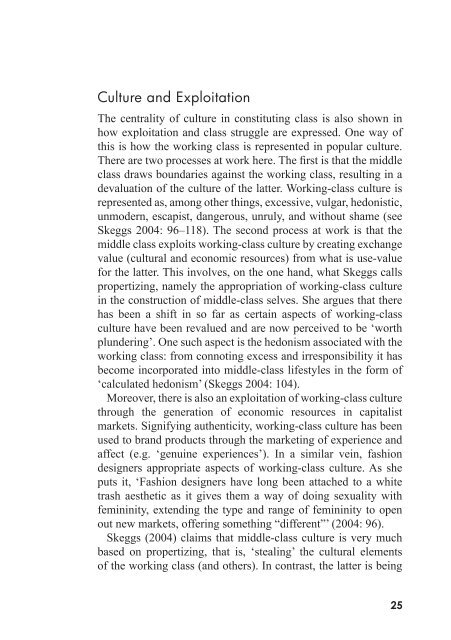Thinking with Bevereley Skeggs - Stockholms universitet
Thinking with Bevereley Skeggs - Stockholms universitet
Thinking with Bevereley Skeggs - Stockholms universitet
- No tags were found...
Create successful ePaper yourself
Turn your PDF publications into a flip-book with our unique Google optimized e-Paper software.
Culture and ExploitationThe centrality of culture in constituting class is also shown inhow exploitation and class struggle are expressed. One way ofthis is how the working class is represented in popular culture.There are two processes at work here. The first is that the middleclass draws boundaries against the working class, resulting in adevaluation of the culture of the latter. Working-class culture isrepresented as, among other things, excessive, vulgar, hedonistic,unmodern, escapist, dangerous, unruly, and <strong>with</strong>out shame (see<strong>Skeggs</strong> 2004: 96–118). The second process at work is that themiddle class exploits working-class culture by creating exchangevalue (cultural and economic resources) from what is use-valuefor the latter. This involves, on the one hand, what <strong>Skeggs</strong> callspropertizing, namely the appropriation of working-class culturein the construction of middle-class selves. She argues that therehas been a shift in so far as certain aspects of working-classculture have been revalued and are now perceived to be ‘worthplundering’. One such aspect is the hedonism associated <strong>with</strong> theworking class: from connoting excess and irresponsibility it hasbecome incorporated into middle-class lifestyles in the form of‘calculated hedonism’ (<strong>Skeggs</strong> 2004: 104).Moreover, there is also an exploitation of working-class culturethrough the generation of economic resources in capitalistmarkets. Signifying authenticity, working-class culture has beenused to brand products through the marketing of experience andaffect (e.g. ‘genuine experiences’). In a similar vein, fashiondesigners appropriate aspects of working-class culture. As sheputs it, ‘Fashion designers have long been attached to a whitetrash aesthetic as it gives them a way of doing sexuality <strong>with</strong>femininity, extending the type and range of femininity to openout new markets, offering something “different”’ (2004: 96).<strong>Skeggs</strong> (2004) claims that middle-class culture is very muchbased on propertizing, that is, ‘stealing’ the cultural elementsof the working class (and others). In contrast, the latter is being25
















